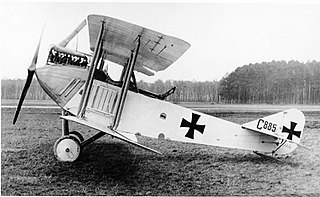
The AEG C.II was a German two-seat biplane reconnaissance aircraft produced in small numbers from October 1915. It was a slightly smaller version of the C.I with better performance, redesigned cockpit for both pilot and observer/bombardier, new rear mounting for a 7.92 mm (.312 in) Parabellum MG14 machine gun, and the ability to carry four 10 kg (22 lb) bombs for light attack duties.

The AEG C.III was a two-seat biplane reconnaissance aircraft, a single prototype of which was built during World War I. The aircraft featured an unusual fuselage design that completely filled the gap between the upper and lower sets of wings, to provide the pilot with improved vision, and to allow the observer a wider field of fire for his 7.92 mm (.312 in) machine gun. The pilot sat to the rear of the observer, who was stationed over the upper wing. This design was not as successful as had been hoped, and the C.III was never entered into service. Despite being heavier than the C.II, its maximum speed increased to 158 km/h (98 mph).

The Albatros C.III was a German two-seat general-purpose biplane of World War I, built by Albatros Flugzeugwerke. The C.III was a refined version of the successful Albatros C.I and was eventually produced in greater numbers than any other C-type Albatros.

The Albatros C.I,, was the first of the successful C-series of two-seat general-purpose biplanes built by Albatros Flugzeugwerke during World War I. Based on the unarmed Albatros B.II, the C.I reversed the pilot and observer seating so that the observer occupied the rear cockpit which was fitted with a ring-mounted 7.92 mm (0.312 in) Parabellum MG14 machine gun.
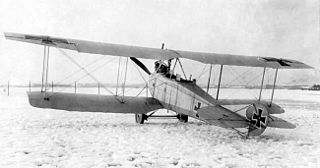
The Aviatik C.I was an observation aircraft which came into service during World War I in April 1915. It was a development of the Aviatik B.I and B.II models, being one of first aircraft of the new German C class of armed biplanes. In the C.I the observer sat in front of the pilot, with a machine-gun clipped on a sliding mounting fitted on a rail at either side of the cockpit. It gave the crew the means to attack enemy aircraft. The positions of the pilot and observer were reversed in last series of 50, ordered in 1917 solely for trainer purpose. There was only one aircraft built of refined C.Ia version in May 1916, with armament still in a forward cab, serving as a prototype for C.III. Later models of the plane included the Aviatik C.II and the C.III, which had more powerful engines. The C.III was produced in large numbers.

Friedrichshafen FF.33 was a German single-engined reconnaissance three-bay wing structure biplane, using twin floats, designed by Flugzeugbau Friedrichshafen in 1914 for the Marine-Fliegerabteilung aviation forces of the Kaiserliche Marine.

The Albatros C.VII was a German military reconnaissance aircraft which saw service during World War I. It was a revised and re-engined development of the Albatros C.V, which had proved disappointing in service.
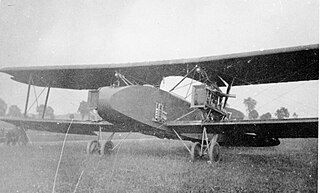
The Albatros G.III, was a German bomber aircraft development of World War I. It was a large, single-bay biplane of unequal span and unstaggered wings. Power was provided by two Benz Bz.IVa pusher engines installed in nacelles carried between the wings. An unusual feature of the design was that the lower wing was provided with cutouts for the propellers, allowing the engine nacelles to be mounted further forward than would have been otherwise possible. Few were built, these seeing service mostly on the Macedonian Front in 1917.
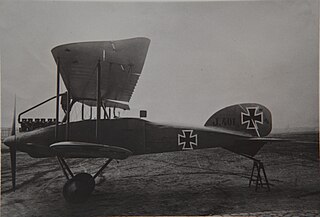
The Albatros J.I was a German armored ground attack airplane of World War I, produced in 1918.

The Friedrichshafen G.I was a prototype heavy bomber aircraft that was built in Germany by Flugzeugbau Friedrichshafen in 1915. It was Karl Gehlen's first design for the company, and although it was not produced in quantity, it provided the foundation for the later, highly successful bombers culminating in the G.III.

The Friedrichshafen G.II was a heavy bomber aircraft that was designed and manufactured in Germany during World War I by Flugzeugbau Friedrichshafen. The plane was used by the Luftstreitkräfte for tactical and limited strategic bombing operations.

The Friedrichshafen FF.31 was a two-seat prototype German maritime reconnaissance floatplane built by Flugzeugbau Friedrichshafen during the First World War. Although primarily intended for reconnaissance duties, the aircraft was provided with a machine gun to engage other aircraft. Although it was satisfactory for its intended mission, it lacked the performance necessary for use as a fighter. A pair of aircraft were built in 1915 and it was not accepted for production by the Imperial German Navy's Naval Air Service.
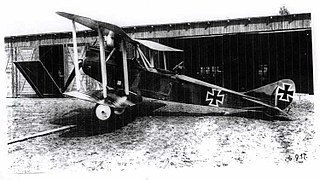
The Rumpler C.IV was a German single-engine, two-seat reconnaissance biplane. It was a development of C.III with different tail surfaces and using a Mercedes D.IVa engine in place of the C.III's Benz Bz.IV. The Rumpler 6B 2 was a single-seat floatplane fighter variant with a 120 kW (160 hp) Mercedes D.III engine built for the Kaiserliche Marine.

Entering service in 1915, the Rumpler C.I,, two-seater single-engine reconnaissance biplane, was one of the first German C-type aircraft, and also one of the longest serving in its class during World War I, being retired from the last front line units only in early 1918.

The DFW C.IV, DFW C.V, DFW C.VI, and DFW F37 were a family of German reconnaissance aircraft first used in 1916 in World War I. They were conventionally configured biplanes with unequal-span unstaggered wings and seating for the pilot and observer in tandem, open cockpits. Like the DFW C.II before them, these aircraft seated the gunner to the rear and armed him with a machine gun on a ring mount. Compared to preceding B- and C-class designs by DFW, however, the aerodynamics of the fuselage were more refined, and when coupled with more powerful engines, resulted in a machine with excellent performance.

The LVG C.II was a 1910s German two-seat reconnaissance biplane designed at the Luft-Verkehrs-Gesellschaft for the Luftstreitkräfte.

The LVG C.V was a reconnaissance aircraft produced in large numbers in Germany during World War I.

The Rumpler G.I was a bomber aircraft produced in Germany during World War I, together with refined versions known as the G.II and G.III.

The Otto C.I, also known as the Otto KD.15, was a German two-seat biplane reconnaissance and bomber aircraft of the First World War designed and produced by Otto Flugmaschinenfabrik. The C.I was a rare example of an aircraft flown by the Central Powers which had a pusher configuration.
The LVG C.VIII was a prototype reconnaissance aircraft built in Germany during World War I.


















